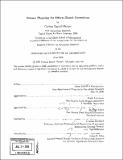| dc.contributor.advisor | Cynthia Barnhart. | en_US |
| dc.contributor.author | Bryant, Corban Harrell | en_US |
| dc.contributor.other | Massachusetts Institute of Technology. Operations Research Center. | en_US |
| dc.date.accessioned | 2007-05-16T19:00:48Z | |
| dc.date.available | 2007-05-16T19:00:48Z | |
| dc.date.copyright | 2006 | en_US |
| dc.date.issued | 2006 | en_US |
| dc.identifier.uri | http://hdl.handle.net/1721.1/37570 | |
| dc.description | Thesis (S.M.)--Massachusetts Institute of Technology, Sloan School of Management, Operations Research Center, 2006. | en_US |
| dc.description | Includes bibliographical references (p. 171-176). | en_US |
| dc.description.abstract | In this thesis. we introduce and analyze methods of creating theater-level robust mission plans for Effects Based Operations (EBO) of teams of Unmanned Aerial Vehicles (UAVs), and propose methods of effectively presenting the robust plan to an end user. Recent conflicts have demonstrated the utility of UAVs in performing Intelligence, Surveillance, and Reconnaissance (ISR) and strike missions. As UAVs become more common, high-level pre-planning and task delegation will increase in complexity, requiring computer aided planning. Traditional planning methods, based on deterministic input data, generate plans that become infeasible in uncertain environments. Because military operations tend to contain substantial amounts of uncertainty and re-planning at a theater level is costly, plans should be robust to uncertainty yet still accomplish desired effects. We present an effects-based planning framework in which we connect end effects to tasks, enabling planners to value task assignments based on their ability to achieve desired effects. We apply two robust planning techniques to this framework (Bertsimas/Sim and Chance Constrained Programming) and analyze their performance. | en_US |
| dc.description.abstract | (cont.) We demonstrate how robust planning increases the length of time that a plan remains feasible in execution and achieves better overall value by avoiding re-planning costs. We analyze strengths and weaknesses of each model and suggest when their use is appropriate. Finally, we apply Hlinan Machine Collaborative Decision Making (HMICDM) concepts to propose methods to facilitate human interaction with a robust effects-based planner. | en_US |
| dc.description.statementofresponsibility | by Corban Harrell Bryant. | en_US |
| dc.format.extent | 176 p. | en_US |
| dc.language.iso | eng | en_US |
| dc.publisher | Massachusetts Institute of Technology | en_US |
| dc.rights | M.I.T. theses are protected by copyright. They may be viewed from this source for any purpose, but reproduction or distribution in any format is prohibited without written permission. See provided URL for inquiries about permission. | en_US |
| dc.rights.uri | http://dspace.mit.edu/handle/1721.1/7582 | |
| dc.subject | Operations Research Center. | en_US |
| dc.title | Robust planning for Effects-Based Operations | en_US |
| dc.title.alternative | Robust planning for EBO | en_US |
| dc.type | Thesis | en_US |
| dc.description.degree | S.M. | en_US |
| dc.contributor.department | Massachusetts Institute of Technology. Operations Research Center | |
| dc.contributor.department | Sloan School of Management | |
| dc.identifier.oclc | 77060615 | en_US |
